Boost Church Engagement with Social Media
- June 24, 2023
- Knowledge Base
- 0 Comments

Social media has undeniably become an integral part of marketing plans across the board, including non-profit entities such as churches.
Yet, you will see a degree of reluctance among some church ministries towards embracing social media. If you find yourself in this category, consider this compelling statistic:
Data reveals that a staggering 18% of young adults and 22% of African-Americans prefer attending church online. This showcases the immense opportunities social media presents for reaching diverse audiences.
Just imagine the possibilities of using social media for churches: your congregation doesn’t merely grow—it thrives. It reaches new members, fosters stronger connections within the community, and effects impactful changes in the wider community.
This is where social media steps in as a catalyst for transforming your vision into reality.
We have created this blog to help you harness the power of social media to boost your church engagement.
This guide will equip you with the best social media strategy for churches, along with content ideas to help you navigate the world of social media to increase engagement and, ultimately, church attendance.
Let’s get started!
5 Remarkable Benefits of Social Media for Churches
You are probably still wondering – “Is social media really worth it for churches?”
Well, let us tell you that whether you represent a traditional church, a modern ministry, or a faith-based organization seeking to expand its reach, social media can do wonders.
Let us check out the five major benefits of using social media for churches.
1. Encourages Sharing Faith and Building Communities
Social media has always been a community-driven platform. No wonder it also aids churches to encourage sharing faith and building communities.
Social media binds your congregation together and provides a platfrom to connect, share testimonies, and uplift one another regularly.
Moreover, social media platforms have become essential for keeping your community informed, aware, and engaged during times of crisis or urgent communication needs.
Now, let’s understand how social media helps you increase your congregation size.
2. Reach New Audiences
Social media breaks down the physical barriers of your church, enabling you to reach new audiences.
You get the opportunity to engage with the younger generation and connect with diverse communities that are increasingly active on these platforms and may not have previously considered attending church.
By tapping into the vast reach of social media and amazing tools, you can expand your church’s influence and make a meaningful impact on a wider scale.
You are probably thinking, wouldn’t it all cost so much?
Let’s check out.
3. Cost-Effective Promotions
Gone are the days of expensive print materials and traditional advertising. Social media offers a cost-effective way to promote church events, ministries, and sermons.
In fact, social media is one of the cheapest digital marketing mediums to promote your church. While its organic promotions are 100% free, its targeted advertising options are cheaper than Google ads.
Plus, you get amazing targeting capabilities to reach the right audience at the right time, maximizing your church’s visibility within your local community and beyond.
By utilizing the power of social media, you can efficiently spread the word and invite more individuals to join your church family.
4. Supports Fundraising and Donations
The mission of churches extends beyond Sunday sermons; it also involves reaching out and supporting people in crisis. And to fulfill this mission, adequate funding is necessary.
That’s where social media platforms help you.
Their vast reach enables churches to support their fundraising efforts and facilitate donations. You can inspire your community to contribute towards your church’s mission and projects through compelling storytelling, engaging content, and online giving options.
5. Encourage Volunteerism
Churches staff often face tasks and responsibilities they don’t have the skill or bandwidth to fulfill. In such cases, they need volunteers to carry out tasks efficiently.
But finding volunteers can be a challenge, right?
Well, social media is a powerful tool to inspire and engage volunteers in your church community. You can post about volunteer opportunities and showcase the impact of volunteering to encourage people.
As we’ve explored the significant benefits of social media for churches, it’s time to delve into the specifics, i.e., which social media platforms you should consider using to market your church.
5 Best Social Media Platforms for Churches to Reach More Worshippers
Let’s identify the most effective platforms to help your church reach and engage more worshippers.
1. Facebook for Churches
With 2.96 billion monthly active users, Facebook still holds the crown of the most widely-used social media platform with a diverse user base. The platform primarily attracts an adult audience, with individuals aged 25 to 34 forming the dominant demographic.


Given these statistics, Facebook is an indispensable tool for churches seeking to connect with their congregation and beyond.
Thanks to its extensive reach and user-friendly features, Facebook allows churches to foster community, engage in discussions, and reach individuals of various demographics.
Let’s take a closer look at how Facebook is great social media for churches:
- Community Building: Community making is the forte of Facebook, giving churches a platform to create and nurture a sense of community. Features such as groups and pages allow churches to discuss, share updates, and encourage engagement among members.
- Live Streaming: With Facebook Live, churches can broadcast worship services, events, and special programs in real time. This feature enables remote worshippers, including those unable to attend in person, to participate virtually.
- Events and Groups: Facebook’s event creation feature is perfect for churches to organize and promote upcoming events, community service projects, or fundraising events. Additionally, groups provide a space for focused discussions, Bible studies, and community support, allowing churches to foster engagement and create meaningful connections.
2. YouTube for Churches
YouTube, second only to Facebook in popularity, boasts 2.6 billion monthly active users. However, it has the most number of monthly visits after Google.
This goes to show the power YouTube holds for churches to share their recorded sermons, worship music, and other inspirational content with a global audience.
Also, unlike Facebook, Youtube appeals to all ages, including Gen Z. Unsurprisingly, 96% of Gen Z users have a YouTube account, while 87% of Millennials are registered on the video platform.
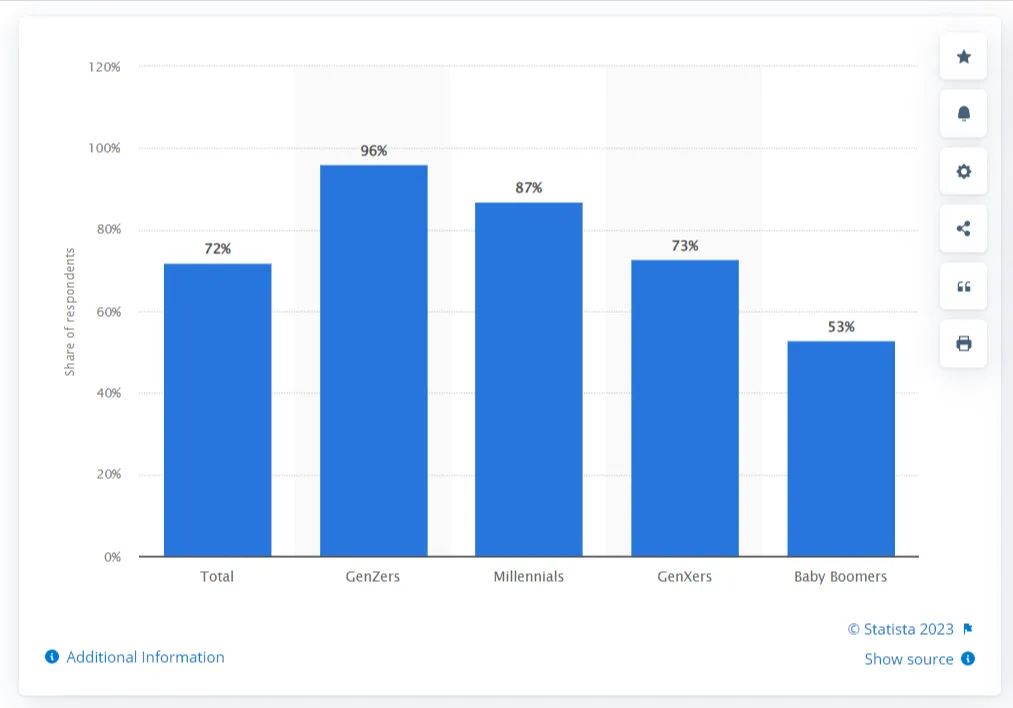

Let’s explore YouTube’s amazing features that will enable churches to reach, engage, and inspire individuals of all ages:
- Video Library: YouTube serves as the world’s largest video gallery. Churches can use their own channel to share recorded sermons, teachings, and inspirational messages. Uploading and organizing content on YouTube will create an always-accessible library of spiritual guidance for your community.
- Live Streaming: YouTube’s live streaming feature empowers churches to broadcast worship services, special events, and sermons in real time. This allows remote viewers to participate actively and engage with the church’s message.
- Playlist Organization: YouTube’s playlist feature enables churches to organize videos by themes, topics, or sermon series. This organization makes it easier for viewers to navigate and access relevant content, ensuring a seamless and enriching viewing experience.
3. Instagram for Churches
Instagram, a visually-driven social media platform, enables churches to showcase their faith, connect with followers, and share impactful moments in a visually appealing manner. It’s particularly popular among younger demographics due to its emphasis on visual storytelling.
Let’s dive more into the platform:
- Visual Storytelling: Through visually captivating images and Reels, churches can effectively convey the essence and spirit of their community, sharing moments of worship, community service, and other inspirational experiences.
- Hashtags and Discoverability: Instagram’s use of hashtags enables churches to enhance their discoverability and reach a wider audience. By utilizing relevant hashtags, churches can connect with individuals who are actively searching for spiritual content or seeking a community of faith.
- Stories and Highlights: Instagram Stories provide an ephemeral and authentic way for churches to share behind-the-scenes moments, devotionals, and daily inspirations. Highlights allow churches to curate and showcase important content for an extended period, making it easily accessible for followers to engage with and revisit.
4. TikTok for Churches
TikTok, the fastest-growing platform, is known for its short-form and creative videos, making it a hit among younger audiences.
But that’s not it.
The platform is a hit among people of all ages, offering churches a unique opportunity to connect with younger and older demographics and creatively express their faith. With its emphasis on trends and user-generated content,
TikTok provides churches with a fresh and engaging platform to share inspiring messages and build a vibrant online presence.
Let’s see what TikTok has to offer churches:
- Bite-Sized Content: TikTok’s short-form video format allows churches to share bite-sized, creative, and impactful content. This format is ideal for delivering quick devotionals, sharing Bible verses, and presenting worship moments in a visually captivating and engaging way.
- Trend Participation: By participating in TikTok trends and challenges, churches can tap into the platform’s viral nature and reach a broader audience. Engaging with popular trends enables churches to creatively express their faith, join cultural conversations, and connect with a younger demographic.
- Authenticity and Relatability: TikTok’s casual and authentic nature enables churches to showcase the human side of their community. By sharing behind-the-scenes moments, volunteer activities, acts of kindness, and personal testimonies, churches can create content that resonates with viewers and fosters a sense of authenticity and relatability.
5. Twitter for Churches
Twitter is the hub of trending news and real-time updates.


Churches can leverage the nature of this platform to share timely information, engage with the community, and foster connections with a diverse audience.
With its emphasis on brevity and hashtag conversations, Twitter provides churches with a valuable tool for spreading their message, joining broader discussions, and staying connected with their congregation.
Here’s why we recommend using TikTok for your restaurant:
- Real-Time Updates: Twitter’s fast-paced, real-time nature allows churches to provide quick updates, share sermon quotes, and announce upcoming events. It serves as a platform for delivering concise and timely information, ensuring the congregation stays informed and engaged.
- Hashtag Conversations: Participating in relevant hashtag conversations on Twitter enables churches to join broader discussions and connect with other faith communities.
- Engaging With the Community: Twitter allows churches to engage with their community through replies, retweets, and likes. By actively participating in conversations and sharing relevant content, churches can foster connections, build relationships, and establish a strong online presence.
Your journey doesn’t end with identifying your best social media for churches. Next, you must develop a comprehensive strategy to make the most of these platforms.
So, let’s dive into a few tips to help you create a social media strategy for churches.
8 Social Media Strategy for Churches
1. Understand Your Target Audience
Recognizing your audience is crucial. Without identifying them, you risk investing resources and energy into initiatives that fail to resonate and connect with the right people.
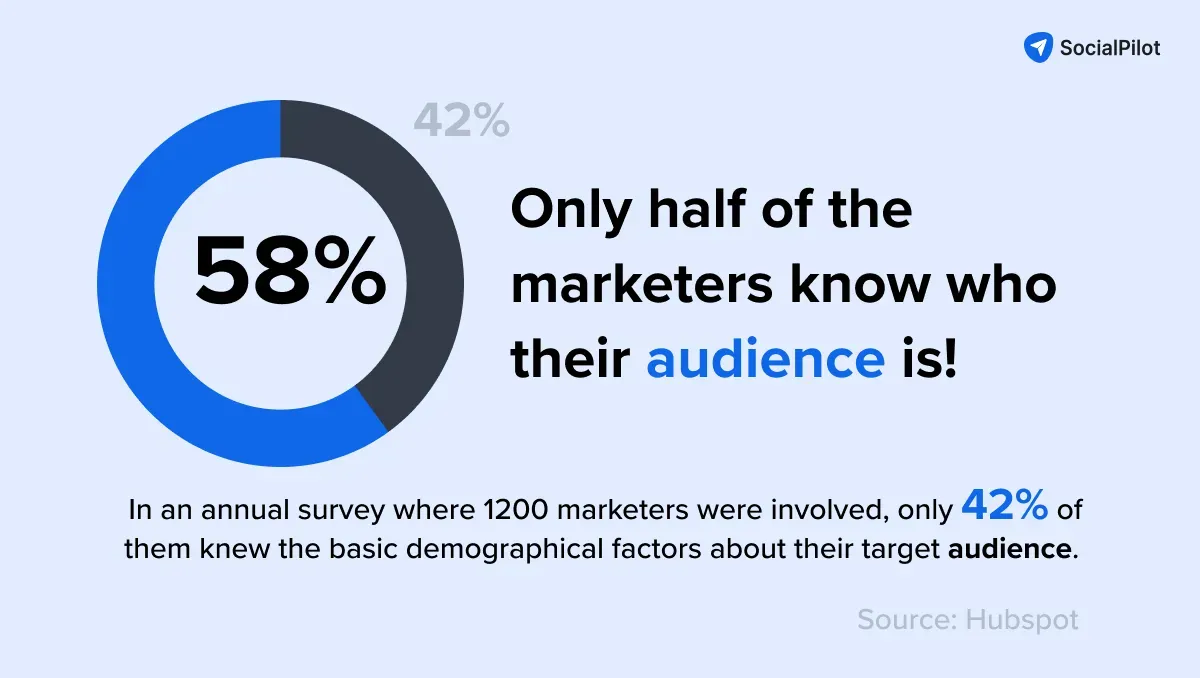

Imagine organizing an event on a weekday afternoon when most of your intended audience is at work or attending classes. That would be a significant waste of resources, wouldn’t it?
So, understand who you want to connect with—whether it’s families, young adults, or a specific demographic within your congregation. This knowledge will guide your content creation and the platforms you choose to focus on. By tailoring your content to resonate with your target audience, you’ll build a stronger connection and engagement with the right people.
Having identified your target audience, let’s explore how to create engaging and relevant content with themed posts.
2. Create Themes for Different Days
Let’s be clear – social media has no content scarcity. Every time users log in, they face fresh content vying for their attention.
Amid such fierce competition, churches must be creative and consistent in their social media posts.
One effective strategy to consistently deliver fresh and original posts that captivate your congregation’s attention and foster meaningful connections is by establishing daily themes. By dedicating each day to a specific category or theme, you can deliver purposeful content that resonates with your audience.
For instance, you could designate Sundays for sharing reflections on the sermon from the previous day. This approach not only provides a structure for your content creation but also offers your audience a predictable and engaging social media experience.
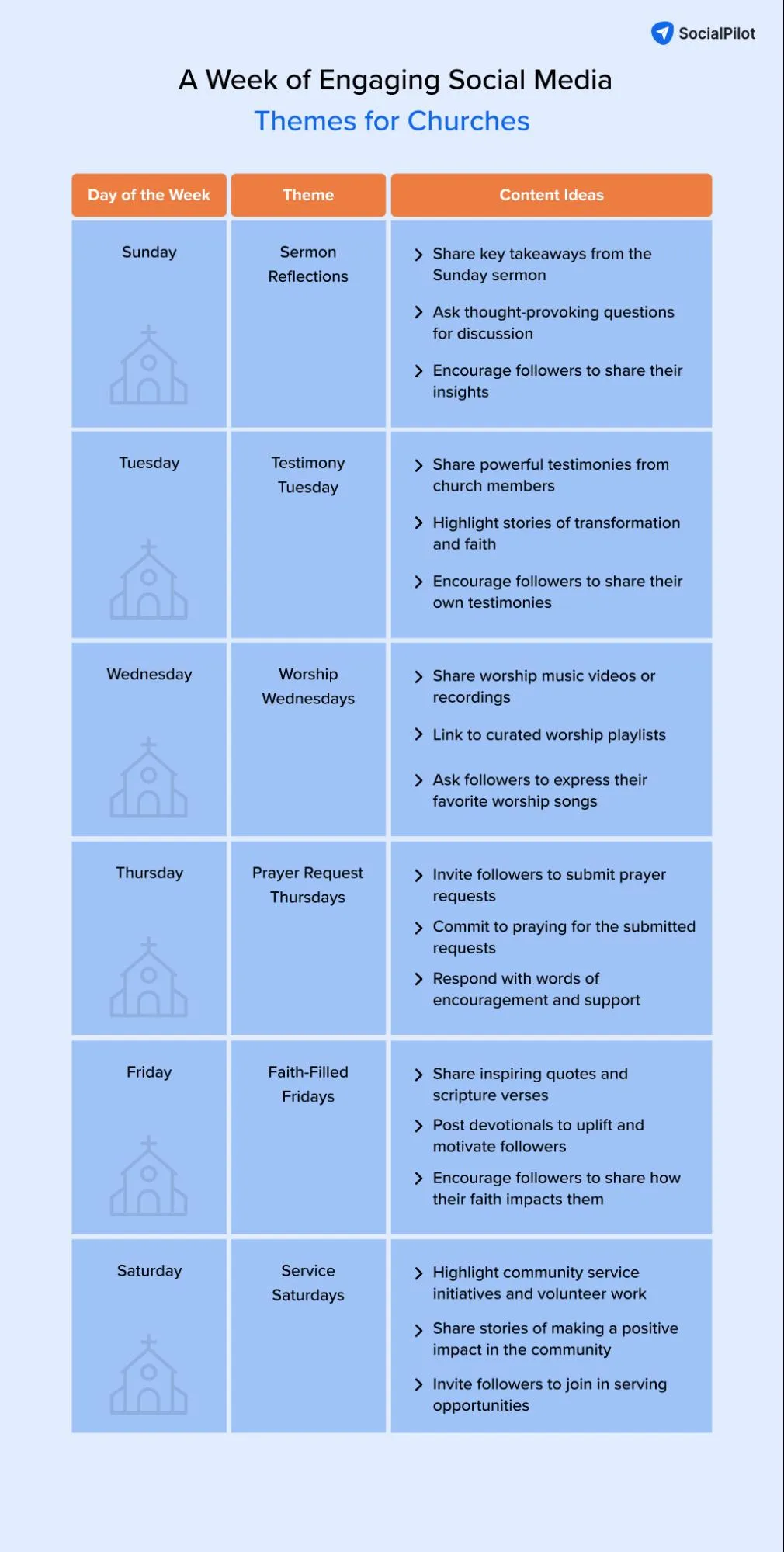

Managing multiple church themes and content for multiple days can be tiresome inside a spreadsheet. Your church needs something better!
Take advantage of SocialPilot’s Calendar functionality to map out weeks and even months of posting plans for all your social networks under one roof. Easily align your messaging with church events and seasons by creating and mapping your content in advance.
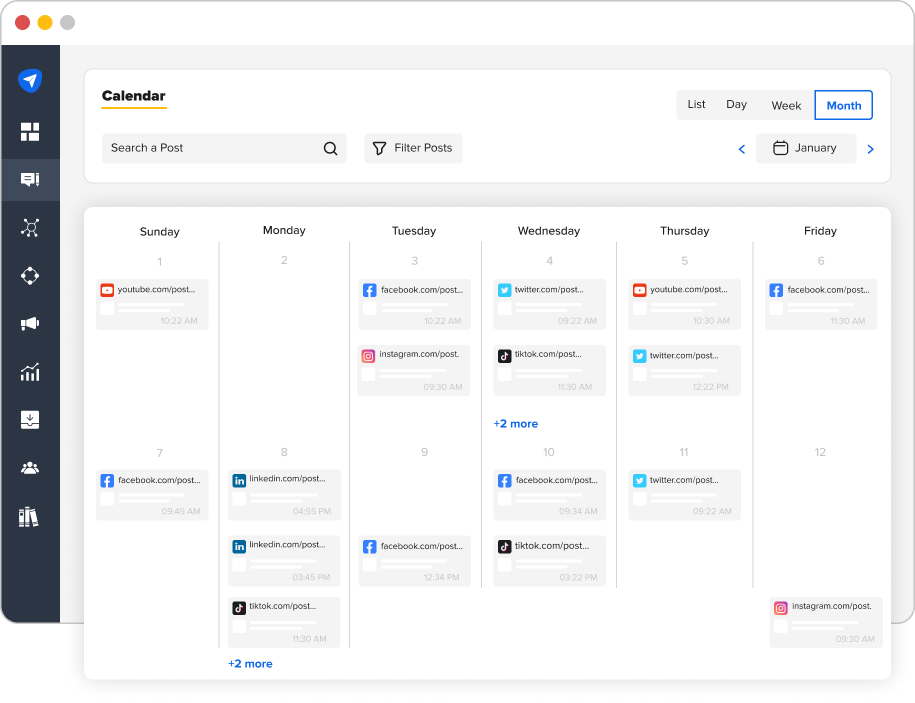

3. Build a Community Through Interactive Content
Social media algorithms favor active and engaging communities. The more engaging you are, the more the algorithm will share your content on other people’s feeds who are relevant to you.
That’s why…
To build a thriving online community, churches must start fostering engagement and meaningful interactions with their followers and the community beyond social media.
How can you achieve this?
Embrace the interactive features of social media platforms.
Use social media polls, ask questions, and leverage quizzes, challenges, and contests to provide a fun and engaging way for members to participate and interact with each other. This encourages friendly competition and collaboration while creating memorable experiences within your community.
However, the most effective way to foster a community is to be there when they have questions or doubts. Swiftly responding to their comments or direct messages will nurture relationships and make your community feel heard and valued.
Is managing and responding to messages and comments from your church’s followers across various social media platforms hard?
Use SocialPilot’s Inbox to simplify social media interactions by bringing all your comments, messages, reviews, and visitor posts from multiple channels under one roof. Streamline your communication and effortlessly stay on top of engagement across different platforms, ensuring no message goes unnoticed or unattended.
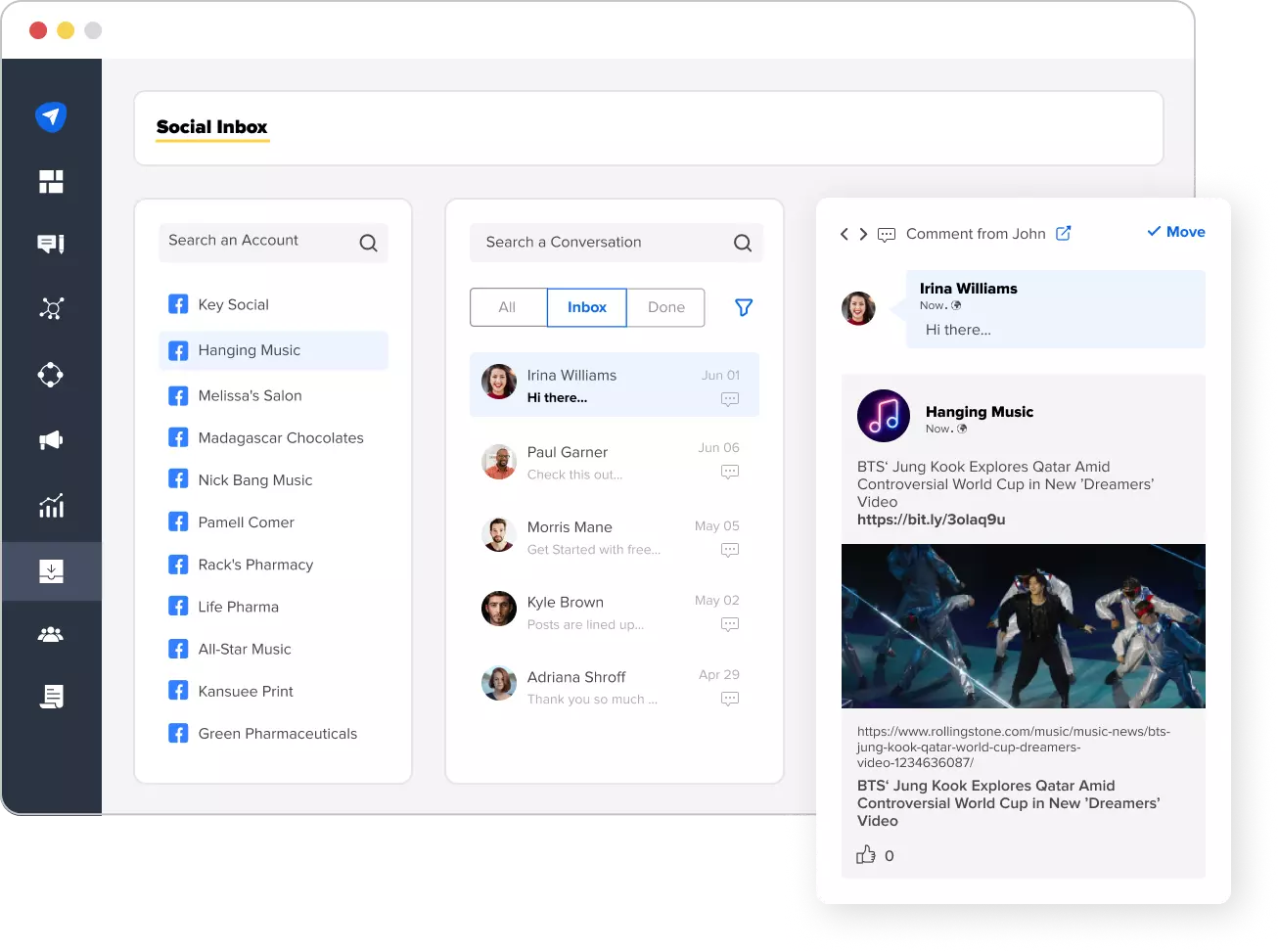

4. Create Social Media Guidelines
Mistakes on social media are easy to make, and we often see brands and businesses committing faux pas in their online interactions. For churches representing themselves on social media, such mistakes can have significant consequences.
That’s why it’s crucial to establish social media policies and guidelines for your church. These guidelines set the tone and expectations for online behavior, providing a framework for your team and congregation to ensure their interactions and communications reflect the values and mission of the church.
Your guidelines should address appropriate behavior, respectful engagement, and the handling of sensitive topics. This way, you can maintain a positive and respectful online environment representing your church community.
5. Use Social Media for Philanthropic Causes
Churches are always involved in philanthropic causes, helping people in need to make a meaningful impact within their communities.
Social media can give you a hand in uniting your community around these causes. By leveraging your social media presence, you can raise awareness and support philanthropic causes that align with your church’s mission and values.
How?
You can share information about local charities, community initiatives, and fundraising efforts to mobilize your congregation and inspire them to get involved.
Social media promotions can significantly encourage donations, volunteering, and sharing the message to increase the reach of these initiatives. This not only fosters a sense of purpose within your community but also makes a positive impact that extends beyond the digital realm.
6. Harness the Power of Live Streaming and Video Content
Videos are the king of content.
They have the power to create a deep emotional connection with your audience, enabling them to connect with your message on a more personal level.
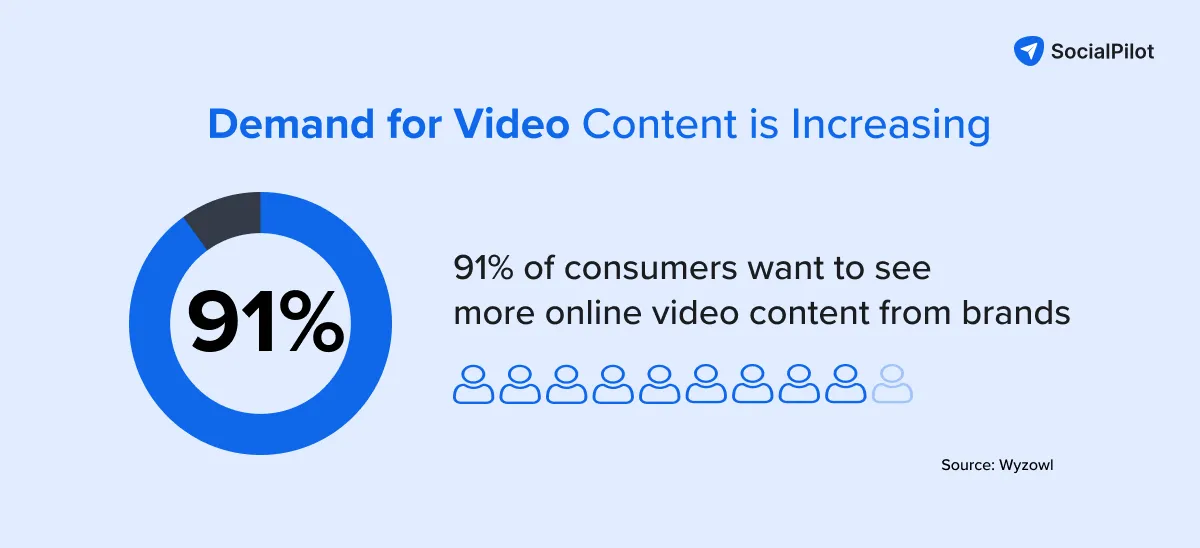

So, how can you use videos on social media platforms?
Videos are a great medium for sharing inspiring messages, testimonies, and impactful stories. Create engaging videos that showcase the transformative power of faith.
You can further amplify the impact of videos by taking them live. Live streaming allows you to broadcast your worship services, events, and special programs in real-time, enabling remote worshippers to participate and experience the service from anywhere in the world.
This is an ideal way to reach a new audience and expand your congregation globally.
7. Engage More With the Facebook Groups
Facebook groups are a great place to create a focused and intimate space for your church members.
Consider it a more tight-knit community catering to specific interests or ministries within your church. In the open world, your followers might hesitate to engage, but here, they get to participate comfortably, share their thoughts, and support one another.
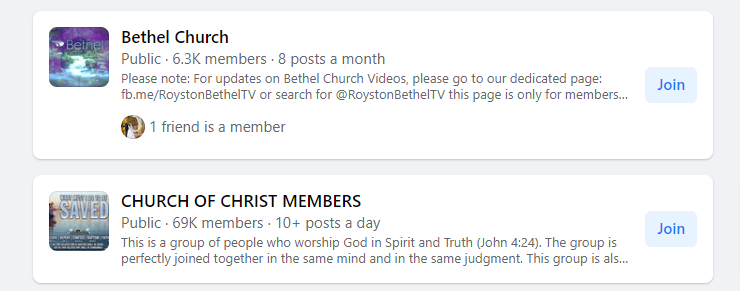

But the onus to get them started lies on you.
Encourage group members to engage in discussions, ask questions, and provide insights related to the specific theme or ministry.
Here are a few things you can do inside your church’s Facebook group:
- Invite members to submit prayer requests
- Facilitate Bible study discussions
- Provide specific ministry updates
- Share upcoming events
- Seek volunteers for various church activities
8. Promote User-Generated Content
One of the remarkable aspects of social media platforms is the potential for user-generated content. When you have a tight-knit community that follows and appreciates what you do, they will naturally post about you.
To drive user-generated content, you need to encourage your congregation to participate and create content on social media actively.
But how can you facilitate this participation?
Start by creating designated hashtags for your church and events, making it easier for members to tag their posts and connect with others who share similar experiences.
Then, it’s your turn to take action.
Showcase user-generated content on your social media channel, such as photos, videos, or written testimonials. Highlighting users’ content not only celebrates the individuals within your congregation but also inspires others to get involved and share their own stories.
SocialPilot: The Best Social Media Tool For Churches
Managing social media marketing can be demanding, especially for church marketers handling multiple accounts. Churches often have a presence on various social media platforms, which can complicate effective management.
The complexity increases when larger organizations, such as a diocese or ministry, are involved. These entities oversee multiple churches or ministries, each with its distinct social media presence. Juggling and coordinating all these individual accounts under the umbrella of the larger organization can become even more overwhelming.
However, there is a solution – SocialPilot!
SocialPilot is a social media management platform made to simplify your multi-platform church marketing.
Let’s look at its notable features:
- Multi-Platform Support: With this feature, you can easily connect and oversee your church’s presence on various platforms, ensuring a consistent and cohesive brand representation across the social media landscape.
- Social Media Scheduling: Scheduling lets you effortlessly plan and schedule posts in advance for multiple social networks. This will empower your church to maintain an active and consistent presence on social media for all events and service days.
- Analytics: Understand the performance of your church’s multiple social media platforms under one dashboard. The feature lets you look at multiple channels’ key insights easily to make better decisions and refine your social media strategies.
- Collaboration: Foster seamless collaboration within your church’s social media team. Invite team members to collaborate on individual social media posts, ensuring smooth workflows for approvals and feedback. Assign different roles to team members to delegate responsibilities effectively and streamline the content creation process.
Conclusion
One thing is for sure – the power of social media for churches cannot be underestimated.
Social media can greatly help churches share their faith, reach a broader audience, and connect more with their congregation. By embracing social media platforms, churches can also encourage volunteerism.
To effectively navigate the digital landscape and unlock new possibilities for your church’s growth, engagement, and community impact, it’s crucial to implement the strategies and content ideas discussed above.
While doing so, if the going gets tough, try your hands on SocialPIlot to streamline your efforts.
Peace be with you all!



